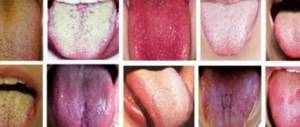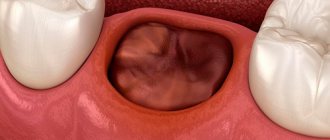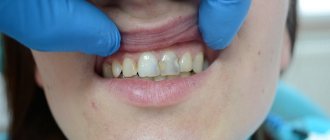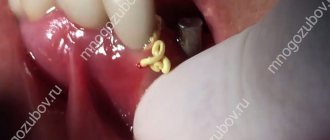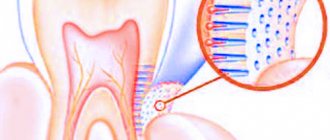Author of the article: Kondratyeva Tatyana Yuryevna, dentist, therapist of the highest category
“Tooth hurts when I bite!” It is with this phrase that patients often begin to describe their complaints at a dentist appointment. However, despite the fact that there is only one complaint, there may be several reasons for it, and in this note I will try to describe the main ones.
First, let's divide them into two groups:
Pain that appeared before visiting the dentist ; Pain that appeared after treatment by a dentist (yes, this also happens!).
Content:
- Why it hurts to press on a tooth - the main reasons 1.1. Increased sensitivity 1.2. Traumatic injuries (history or recent) 1.3. Periodontitis 1.4. Inflammation of the gums 1.5. Poor quality dental prosthesis 1.6. Cyst 1.7. Caries 1.8. Pulpitis
- If pain occurs when pressing on a filled tooth
- What you can do yourself
When pain occurs in a tooth affected by caries, or at the base of which there is swollen and inflamed gum, everything is clear - you urgently need to go to the dentist and undergo treatment. But what to do if a person’s tooth hurts when biting and no visual defects are noticeable.
Is it possible to ignore this situation? Dentists are convinced that no. If acute or aching pain occurs when pressing on a tooth, you must definitely find out its cause. Otherwise, the risk of crown failure or root damage will increase in the future.
The first group includes:
Caries
A carious cavity is a depression in the hard tissues of the tooth that appears as a result of their destruction. Food or drinks (most often cold) enter the cavity and cause short-term (several seconds) pain. If food is retained in the carious cavity (especially sweet food), the pain may last longer.
Seal defect
If part of the filling (or part of the hard tooth tissue around the filling) placed previously breaks off under the influence of chewing load, a part of the tooth that is more sensitive to the effects of food is exposed.
Chronic apical periodontitis in the acute stage
It sounds scary...and in reality it is no less terrible. The mechanism of pain in this case is quite simple. Around the apex of the root, surrounded by a dense bone plate, the inflammatory process is activated. Inflammation in all parts of our body proceeds along approximately the same path and is characterized by an increase in the volume of inflamed tissue (due to blood flow to the affected area). And if this happens, for example, when a hand is bruised, then we will see swelling, that is, an increase in volume. Now let’s imagine the formation of a “swelling” in the area of the root apex surrounded by a dense bone plate... there is no room for the incoming fluid, the nerve endings are compressed, and here you are also trying to chew a delicious steak!
Periodontitis
One of the causes of tooth pain is periodontitis.
The thing is very unpleasant (like most dental diseases). It is characterized by a long-term, most often sluggish inflammatory process of all tissues surrounding the tooth (gums, ligaments, bone surrounding the tooth), leading to their atrophy (reduction). As a result, the tooth becomes mobile and cannot withstand the chewing load, which is indicated by pain.
Functional overload
Each of our teeth, depending on the function it performs, is designed for certain chewing loads. However, if for some reason the number of teeth decreases (extraction, injury, etc.), the remaining ones begin to experience increased chewing pressure (for themselves and for the lost ones). Such excessive load leads to loosening of the tooth and the appearance of the symptom we are discussing. Only high-quality prosthetics will help solve this problem.
Injury to the gingival papilla by hard food
The reasons for this phenomenon may be:
Large distances between teeth (diastema and trema). They can be either physiological in nature (features of the anatomical structure) or pathological (for example, “divergence” of teeth during periodontitis);
Poorly restored contact point
A contact point is a point or area through which adjacent teeth contact each other and through which chewing pressure is distributed. If the carious cavity was located on the side surface of the tooth and after filling it, the contact point was not properly restored, then food will get clogged between the teeth when chewing, injuring the gingival papilla. Hence the pain. This reason relates more to the second group, so let’s move on to it.
Why it hurts to press on a tooth - the main reasons
The causes of pain in a molar, incisor or canine when pressing on it can be very different. Below we will talk about the most common ones.
Increased sensitivity
If unpleasant sensations are associated precisely with this, then they can remind of themselves without any serious reasons. A person simply needs to clench their jaws more tightly to experience discomfort. In such a situation, you should use special toothpastes and remineralizing gels. Pharmacy mouth rinses will also help improve the situation.
If it is not possible to eliminate the manifestations of the pathological condition using standard hygiene products, it is recommended to make an appointment with a dentist. The dentist will treat the teeth with a fluoride-containing strengthening composition, which will improve the situation.
Traumatic injuries (history or recent)
A very common reason. Usually a person who has suffered a jaw injury understands what causes his discomfort. It is important to realize that injuries are not necessarily the result of falls or fights. Sometimes it's enough to eat a handful of nuts or chew crackers to get a problem.
When exposed to mechanical stress, cracks appear on the enamel surface. They are the ones who cause unpleasant dental symptoms. It is not possible to close them on our own. It is imperative to visit a doctor so that he can provide the necessary treatment.
Periodontitis
Complication of advanced caries, injury or poorly performed dental treatment. With it, the periodontium becomes inflamed - a narrow space located between the crown and the socket. The pathology occurs in acute or chronic form.
Therapy for periodontitis must be comprehensive. Need to:
- get rid of the inflammatory focus;
- clean the dental canals and create conditions for the unhindered outflow of exudate;
- administer antibiotic therapy;
- use medicinal baths.
Good dynamics during the disease are provided by UHF to the affected area.
Gum inflammation
Another reason why a tooth hurts when pressed. Here you need to carry out a differential diagnosis - first press on the gum, and then on the crown. If the problem is damage to soft tissues, then a negative symptom will arise precisely when pressing on them.
Treatment for gum inflammation includes:
- carrying out anti-inflammatory baths;
- exclusion of irritating factors that negatively affect the gums;
- carrying out physiotherapeutic procedures, gum massage;
- vitamin therapy;
- mouth rinse;
- oral administration of medications that help to quickly relieve inflammation.
Poor quality dental prosthesis
It is very important that the installed structure exactly matches the characteristics of the patient’s oral cavity . It is unacceptable for artificial units to be higher or lower than those given by nature. This will create unnecessary pressure on antagonistic neighbors.
It also happens that the doctor performed poor-quality root canal treatment before prosthetics. This led to inflammation. Then you will have to remove the prosthesis and re-treat the canals, and then repeat the prosthetics from the very beginning.
Of course, such situations are very unpleasant and leave a lot of negative emotions and experiences in the patient’s memory. That is why it is so important not to go to a clinic where it is cheaper, but to contact experienced doctors who guarantee the impeccability of the final result.
Cyst
They speak of a root cyst when they see a spherical formation filled with liquid contents . It appears after an injury, as a result of infection of the root canals, due to the introduction of infection into the periodontal zone by a non-sterile medical instrument.
It is important to establish the true cause of the cyst and carry out its step-by-step treatment. When the situation returns to normal, pain symptoms will cease to bother you.
Caries
It would seem that it is not difficult to notice caries and understand that it is the cause. But it is not always the case.
If the carious cavity is at the spot stage , it may be completely invisible to a person. The situation is similar if the “hollow” is located between neighboring units.
To understand the root cause of the problem, you need to conduct a dental examination. To reduce the risk of cavities, you should have checkups at your dentist's office every six months.
Pulpitis
A disease that every person faces sooner or later. It affects nerves and blood vessels located in the root system. With pulpitis, painful symptoms occur:
- when pressed;
- when eating cold or hot food;
- when trying to chew something hard.
Treatment is carried out under local anesthesia. The doctor opens the upper part of the crown and puts in the medicine. After the specified period, the patient comes for a follow-up appointment. Then the medicine is removed, the canals are cleaned, expanded and sealed. Finally, a permanent filling is installed.
It is very important not to delay treatment of pulpitis. This disease is very insidious. Among its consequences:
- destruction of bone tissue;
- periostitis;
- periodontitis;
- destruction of the ligaments holding the canine, incisor or molar (this leads to its loosening and premature loss).
How to close a gap between your front teeth
External and lingual braces
Braces are one of the most famous and popular ways to eliminate the problem of incorrect teeth position.
Even until relatively recently, the aesthetic side of the issue repelled many patients from wearing braces, especially teenagers. After all, they were made exclusively from metal and were attached from the outside. Therefore, the gap between the teeth, in addition to everything, also became a psychological problem. During treatment, patients complained about their appearance. Modern medicine has made significant progress in this direction: orthodontists now recommend lingual braces to patients. Since they are attached to the back surface of the teeth, they remain almost invisible. In some cases, even braces are not needed to eliminate gaps - doctors prescribe aligners (transparent aligners).
Lingual braces have one minor drawback - the patient takes longer to get used to such microprostheses than to the external type.
Braces can be plastic or metal, ceramic or sapphire. The former are noticeably cheaper, but they are not as durable as their metal counterparts. Ceramic and sapphire look very aesthetically pleasing. When choosing one option or another, it is worth consulting with a doctor, who will point out certain characteristics of one or another option and the priority of specific models for you. After all, for example, sapphire braces will not look beautiful on those who have a yellow tint to their teeth.
Installation of braces is carried out in two ways - direct and indirect. In the first option, the orthodontist, checking his actions with the photographs, installs the locks individually, one on each of the teeth. This work is almost like jewelry, since it is extremely important to maintain maximum precision. In most cases, orthodontists today resort to this method.
The second is indirect. Experts are convinced that this is the future. The orthodontist makes an exact plaster copy of the teeth and places clasps on it. Afterwards everything is transferred to a mouthguard, which is placed on the dentition. That is, the doctor fixes the system at the same time. This method is very convenient for both the orthodontist and the patient.
The material and design of high-quality modern braces in no way affects the effectiveness of treatment. Typically, a microprosthesis is worn for 1-2 years. The period depends on many factors, including the characteristics of the individual’s body.
The use of braces is considered the most correct method, even tooth-friendly. If we are talking about treating teenagers, then you should resort exclusively to braces.
If pain occurs when pressing on a filled tooth
It happens that outwardly the unit looks fine (the filling is sealed, the crown has not changed its color), but, nevertheless, painful symptoms periodically make themselves felt. This situation is considered normal only in the first day after the filling is installed. Then the pain should disappear. If it persists for a long time, then something is wrong.
Most likely, an inflammatory reaction has developed. She needs to be docked. To do this, you should make an appointment with your dentist. The doctor will conduct an in-person examination, instrumental examination, and take pictures. This will allow him to understand why the pain appeared and, based on the information received, create a progressive treatment plan.
Types of diastemas
True. In the area of the gap on the x-ray there is a slight compaction. The gap was formed due to improper attachment of the lip frenulum. Otherwise, the dental system has a normal structure.
False. The appearance of a distance between the central incisors is a secondary problem associated with the incorrect structure of the dentition, supernumerary rudiment, loss of molars, and lateral incisors. The labial frenulum has normal dimensions and attachment.
What you can do yourself
If the tooth hurts severely, and for some reason it is impossible to get an appointment with a doctor today, you should rinse with a saline or soda solution. Warming compresses should never be used - they often aggravate the inflammatory process and provoke blood poisoning.
For unbearable pain, you can take an over-the-counter analgesic available in your home medicine cabinet. But this should be a “one-time event”. As soon as possible, the patient should see an experienced dentist.
Treatment of diastema
Performed in one of three ways.
Direct restoration. Used for microdentia, with irregularly shaped crowns. The dentist performs an aesthetic restoration by “building up” the crowns to close the gap. The method is used when the tooth roots are correctly positioned (the appearance of a chip is associated only with the shape and size of the central incisors).
Installation of veneers. Veneers mask an aesthetic defect and close the diastema. Used for microdentia, for minor defects in the structure of the dentition (affect only the central incisors). Veneers are installed on the front teeth to straighten them, remove gaps, and restore the aesthetics of the smile.
Orthodontic treatment. It can be performed using a braces system or a mouthguard. For correction, a directed low force is used - the incisors move slowly, the gap is closed gradually. Orthodontic treatment is used for incorrect position of tooth roots, if the appearance of a diastema is associated with the structure of the dental system.
Teeth began to separate
The front lower teeth and upper teeth gradually fan out between
itself and gaps appear between the teeth? Previously, they stood in beautiful, even rows, and then suddenly, for no reason at all, they began to move. Why?
The fan-shaped divergence of the front group of teeth, or rather their position is called protrusion! Teeth pushed forward are an aesthetic flaw that changes the appearance, so you have to make a lot of effort to close your lips! Exposed tooth roots and mobility cause patients considerable discomfort when chewing and biting food. This is a characteristic sign of moderate to severe periodontitis.
Causes of teeth discrepancy.
The supporting apparatus of the teeth that holds the teeth in the bone socket is called the periodontium. The main function of the periodontium is to firmly hold the tooth with the help of an elastic ligament. The elastic ligament firmly covers the tooth and prevents
penetration of infection between the tooth root and the bone socket. The tooth is suspended in the socket and can make small movements. That is, the healthiest and most stable tooth has insignificant mobility. If it weren't for it, the teeth wouldn't last as long. Because of this mobility, the periodontium has a trophic function - it nourishes the tooth during chewing. As periodontitis progresses, the circular ligament of the tooth is damaged and over time it completely disappears! And this is due to periodontitis, which lasts for a long time in a latent form and has a chronic course. With moderate periodontitis, bone tissue is already involved in the inflammatory process. Constant destruction of bone tissue leads to exposure of the tooth root. A tooth deprived of stable support can no longer withstand chewing loads and this leads to an increase in tooth mobility. Once started, this process continues to develop uncontrollably and leads to the tilting of the teeth, their “fan” arrangement. A factor of traumatic occlusion arises, in other words, during normal chewing, the antagonists (the group of teeth opposite to it) are knocked out by their own teeth. In the absence of proper treatment for periodontitis, such a group of teeth loses their stability and eventually must be removed.
Among the main causes of a local nature in the oral cavity are:
- Incorrect bite.
- Pathological abrasion
and overload of the supporting apparatus of the tooth. - Poor oral hygiene.
- Untreated gingivitis
. - Errors in prosthetics with crowns and bridges, veneers.
- Incorrectly placed fillings when filling teeth.
What to do if your teeth start to come apart?
In such a situation, an urgent consultation with a periodontist is necessary!
Only a person can identify the cause, eliminate it and prescribe adequate treatment.
periodontist-surgeon.
Unfortunately, today, the level of training of dentists in gum diseases is extremely low. And the patient is unaware of his diagnosis for a very long time, and when the situation in the oral cavity worsens sharply, the diagnosis of periodontitis is made. The advanced stage of periodontitis not only requires considerable effort from the periodontist, but also treatment for the patient is expensive and requires large financial costs. As a rule, in such situations, a full range of periodontal procedures is required, using laser technology
,
open curettage , flap operations
and, after three months,
the Vector procedure
.
Unfortunately, as a splinting
, it is not a treatment for periodontitis; it is simply a preparatory step in the treatment of moderate to severe periodontitis.
It is worth noting that splinting, even highly mobile teeth, allows you to connect them into a fixed block for a long time, evenly distribute the chewing load and makes it possible to carry out high-quality surgical procedures in the treatment of periodontitis. Surgical treatment
remains the leading treatment for moderate and severe periodontitis!
Three golden rules that will save your teeth.
Necessary:
- Professional examination every six months by a periodontist.
- Consultation with a periodontist before installing crowns, bridges, veneers and
orthodontic treatment. - After prosthetics and fillings.
Here are three simple rules that do not require any financial costs from the patient, but will allow you to identify periodontitis at the initial stage and monitor the work of the orthopedic dentist, therapist and orthodontist.
IMPORTANT:
It is always easier to prevent and eliminate the causes than to deal with their consequences.
With timely and competent treatment of periodontitis, you can preserve your teeth and the beauty of your smile for a long time. Do not forget to visit a periodontist once every six months for the purpose of prevention and periodontitis will not overtake you!
